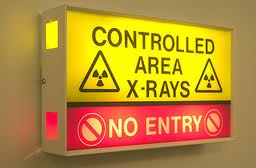 You can't see it, you can't feel it, you forget about it, but it's there. Every time you press the foot pedal in the catheter laboratory you are delivering X-rays to the patient but also to yourself and other people in the room. After years of performing angiography and coronary intervention what is the effect of all that X-ray exposure on the operator? This is an important issue for cardiologists and radiologists who frequently perform interventional procedures. When we enter the catheter laboratory we dress for battle. Lead skirts and tops are worn, a thyroid shield and sometimes lead glasses. However the number and complexity of interventional cases is rising and with it radiation exposure. The trunk, thyroid and eyes may be protected the head is completely exposed. So this leads the first question: Is there a higher risk of brain tumours in interventional cardiologists? In 2012 data was presented on 9 interventional cardiologists and radiologists with left sided brain tumours. The paper was small and could not prove a link but the authors invited doctors to report any other cases they were aware of. This resulted in a second publication in 2013 reporting data on an extra 22 cases of brain and neck cancers from around the world in 23 interventional cardiologists, 2 electrophysiologists and 6 interventional radiologists. All of them had worked for prolonged periods (23.5±5.9 years) in active interventional practice with exposure to ionizing radiation in the catheterization laboratory. In 26 cases data was available regarding the side of the brain involved and 85% were on the left. In response to this Worldwide Innovations and Technologies now produce a lightweight (50g) disposable surgical cap called the "No Brainer" which reduces radiation exposure to the head of the operator by more than 80%. If your catheter laboratory doesn't have them perhaps you should be asking why? What about other parts of the body? Chronic radiation exposure to the skin of the legs occurs and there are reports of some interventional cardiologists noticing the onset of leg hair loss caused by chronic occupational radio-dermatitis. The introduction of shin protection markedly reduces radiation exposure to this area. We have personal dosimeters in the catheter labs but they are worn inconsistently and no feedback is given on the exposure recorded from them. Even if we did get the data it is retrospective and does not allow for any rapid changes in practice. Reducing screening and acquisition time is important but this comes with experience. I try and instil into my fellows the importance of performing the procedure with the shortest possible screening time and for an uncomplicated radial approach coronary angiogram it possible to shorten this to less than 1-2 minutes. Using the fluoro-acquire function during angioplasty also greatly reduces the number of formal acquisitions and therefore the radiation dose. What if you were to give operators immediate feedback on radiation exposure. This has recently been examined in the RadiCure study. This showed that wearing a personal real time radiation-monitoring device that beeps faster as radiation exposure increases reduces radiation exposure by a third. The study used the interactive Bleeper SV device and the immediate feedback allows cardiologists to make changes during a procedure to reduce X-ray exposure such as adjusting the radiation protection shield, moving further away from the X-ray source or reducing the frame rate. Radiation protection not regarded as the most exciting subject when taught as part of an IRMER course at the beginning of you career as an cardiology trainee. I believe that introduction of better protection to the head and legs and the use of real time radiation protection devices would be of valve in improving catheter lab safety for the operator. I would value any comments from people who have used the Bleeper SV device or the No Brainer head protectors.
0 Comments
Your comment will be posted after it is approved.
Leave a Reply. |
Dr Richard BogleThe opinions expressed in this blog are strictly those of the author and should not be construed as the opinion or policy of my employers nor recommendations for your care or anyone else's. Always seek professional guidance instead. Archives
August 2023
Categories
All
|
 RSS Feed
RSS Feed

